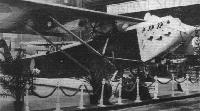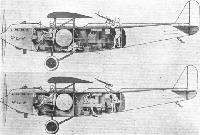
Fokker C.VIII-W
В 1928 году "Fokker" построила единственный C.VIII - одномоторный легкий разведчик-бомбардировщик, оснащенный двигателем Hispano-Suiza 12Lb мощностью 670 л. с. (500 кВт). Авиакорпус голландской Армии приобрел данную машину, но дальнейшего заказа не представил. Однако, когда морской авиации голландских ВМС потребовался новый разведывательный гидросамолет, компания модифицировала базовый проект под новые требования - самолет получил обозначение C.VIII-W. Первый его полет состоялся 15 ноября 1929 года, а в 1930 году был получен контракт на поставку девяти таких самолетов.
На момент вторжения немецких войск в Голландию в эксплуатации еще находилось несколько таких гидросамолетов. Их успели перегнать во Францию, где они патрулировали французское побережье в районе Шербура, после чего 26 гидросамолетов, включая и пять C.VIII-W, перелетели 22 мая в Калшот (недалеко от Саутгемптона, Великобритания). Позже самолеты были переданы в распоряжение военно-морского испытательного центра, но ввиду нехватки запчастей и по ряду других причин вскоре были списаны.
ТАКТИКО-ТЕХНИЧЕСКИЕ ХАРАКТЕРИСТИКИ
Fokker C.VIII-W
Тип: трехместный разведывательный гидросамолет
Силовая установка: один W-образный ПД Lorraine-Dietrich мощностью 450 л. с. (336 кВт)
Летные характеристики: макс. скорость на уровне моря 195 км/ч; крейсерская скорость на оптимальной высоте 160 км/ч; практический потолок 4300 м; дальность 900 км
Масса: пустого 1915 кг; максимальная взлетная 2750 кг
Размеры: размах крыла 18,10 м; длина 11,50 м; высота 3,80 м; площадь крыла 44,00 м2
Вооружение: два 7,9-мм наводимых пулемета в задней кабине и один 7,9-мм наводимый пулемет в средней кабине
Описание:
- Fokker C.VIII-W
- Flight, July 1928
THE PARIS AERO SHOW 1928
Фотографии
-
Flight 1928-07 / Flight
A New Fokker Type: The C.VIII is a strut-braced parasol monoplane designed for long-distance reconnaissance.
-
Мировая Авиация 134
Изображен первый из полученных голландской морской авиацией самолетов C.VIII-W.
THE LATEST FOKKER SEAPLANE: This machine, type C.VIII-W with 450 h.p. Lorraine Engine, has been supplied to the Dutch Navy and is intended for sea reconnaissance. Owing to the absence of cross members in the float suspension, the machine can also be used for training crews in dropping torpedoes. The strutting of the float chassis would almost pass the ancient British ''Thrust Test." -
Flight 1928-07 / Flight
Interior arrangement of the Fokker C.VIII: The lower view shows position of crew while working, and the upper, the fighting positions of the two gunners.
- Фотографии


